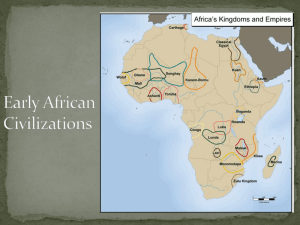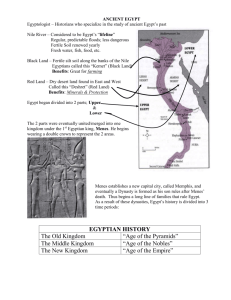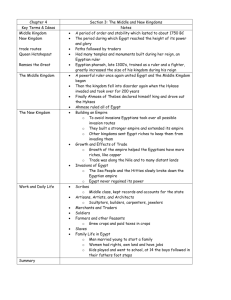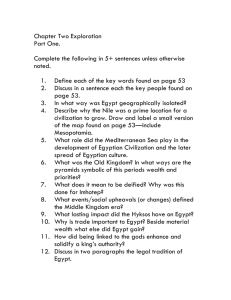ANCIENT CIVILIZATIONS Egypt -
advertisement
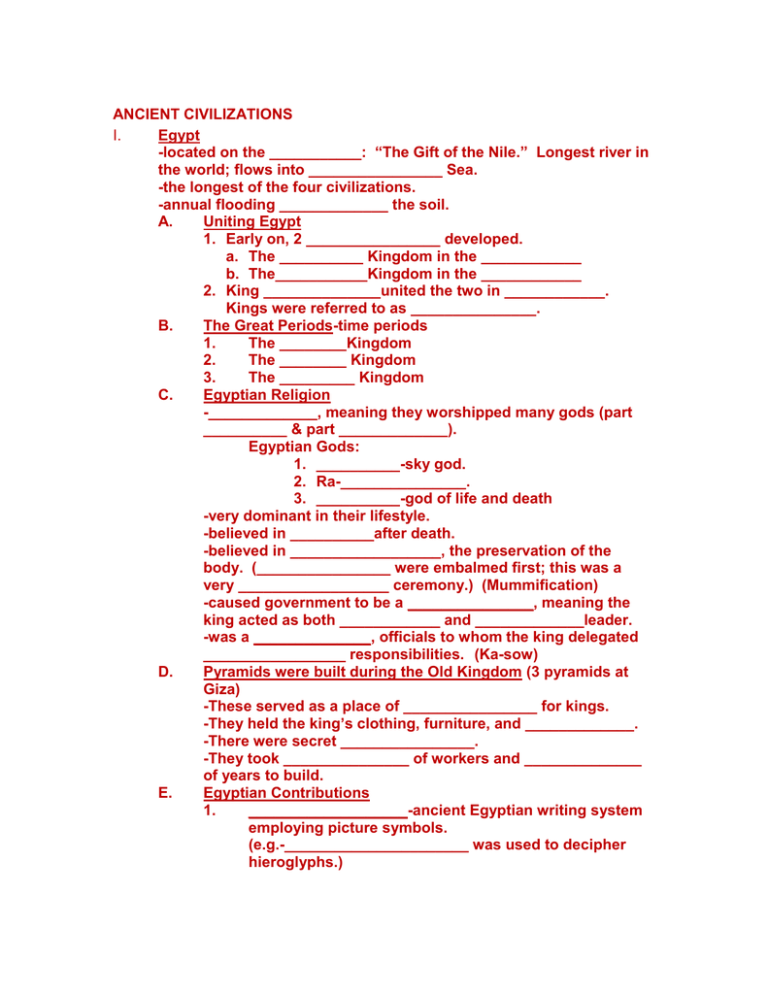
ANCIENT CIVILIZATIONS I. Egypt -located on the ___________: “The Gift of the Nile.” Longest river in the world; flows into ________________ Sea. -the longest of the four civilizations. -annual flooding _____________ the soil. A. Uniting Egypt 1. Early on, 2 ________________ developed. a. The __________ Kingdom in the ____________ b. The___________Kingdom in the ____________ 2. King ______________united the two in ____________. Kings were referred to as _______________. B. The Great Periods-time periods 1. The ________Kingdom 2. The ________ Kingdom 3. The _________ Kingdom C. Egyptian Religion -_____________, meaning they worshipped many gods (part __________ & part _____________). Egyptian Gods: 1. __________-sky god. 2. Ra-_______________. 3. __________-god of life and death -very dominant in their lifestyle. -believed in __________after death. -believed in __________________, the preservation of the body. (________________ were embalmed first; this was a very __________________ ceremony.) (Mummification) -caused government to be a _______________, meaning the king acted as both ____________ and _____________leader. -was a ______________, officials to whom the king delegated _________________ responsibilities. (Ka-sow) D. Pyramids were built during the Old Kingdom (3 pyramids at Giza) -These served as a place of ________________ for kings. -They held the king’s clothing, furniture, and _____________. -There were secret ________________. -They took _______________ of workers and ______________ of years to build. E. Egyptian Contributions 1. ___________________-ancient Egyptian writing system employing picture symbols. (e.g.-______________________ was used to decipher hieroglyphs.) 2. 3. 4. 5. __________________-enabled them to calculate area and volume. ________________-used to survey flooded land. ________________-An accurate 365 day calendar. ________________-Not only embalming, but doctors used splints, bandages, and compresses when treating fractures, wounds, and diseases. II. India-Indus River Valley -surrounded by _______________: ________________. The mountains served to block cold weather out of the valley and as protection. -Due to seasonal _________________, soil was rich for seasonal crops. -They had to deal with __________________-seasonal winds that would bring heavy rainfall. A. India’s Religion 1. ______________-polytheistic; the people believed in yoga and fasting, worshipping the cow. Major concepts: a. ___________-righteous living; duties to fulfill. b. ___________-all actions have a consequence. c. ______________: rebirth of the soul after death. 2. ______________-founded by Siddharta Gautama, b. 566 B.C. (Buddha-The _______________One). Buddha, a prince, wondered, meditated, fasted, denied himself pleasure, searching for a solution to end ____________ and _______________. Comprised Four _____________Truths: a. All know _______________ and sorrow. b. Suffering is caused be ________________. c. People end suffering by eliminating their _______________. d. Eliminate desires by knowing __________, resisting _________, saying nothing to hurt others, controlling ________________, meditating, etc. *The goal was to achieve __________________, meaning one could be one with the universe. B. Contributions: 1. ______________ to make contracts. 2. Straight ______________ 3. ____________ for irrigation III. China-Huang River Valley -These people lived in isolation because of the Himalayas, near the Yellow Sea. Chinese history is divided into _________________. Rulers of China (from the same family) had a mandate from heaven to form a ____________________. Most important dynasties: Shang, Zhou, Quin, & Han A. Religion 1. ____________________ Confucious (b. 551 B.C.) was poor and sought to end __________________by fulfilling a role in society. He had many wise _______________, such as “Do not do unto others as you would not want done unto you.” 2. ______________ -rejects social structures; belief in the fact that __________________ attract and Yin/Yang-life must be kept in _________________. B. Contributions to Society: 1. System of ____________ and __________________ 2. _______________ system 3. Educated ______________ 4. ___________ trade 5. _____________ (pottery) 6. The _________________ for protection IV. Mesopotamia-Greek for “land between the rivers.” -located between the Tigris and Euphrates Rivers in the Fertile Crescent. -Sumerian farmers first built ___________ to control flooding, and constructed ______________ and ditches to bring river water to irrigate their fields. Fertilized land produced food (grain crops) by _____________ B.C. A. Religion 1. _________________; their gods had specific powers over natural forces and human activity. 2. Their gods were ________________ and ____________. 3. Humans had little control over their ____________. 4. They built _________________(temples) where the gods lived. (similar to ________________) 5. __________________-the religious leader was also the political leader; he was the mediator between the __________ and the people. B. Writing 1. _________________ were used; they also developed a model for the alphabet. 2. ______________ wrote on clay; tablets had to dry. 3. They wrote ______________-long poems (e.g.Gilgamesh,) 4. They wrote __________________-short bits of advice. a. b. 5. C. V. One bird in hand is worth two in the nest. A good plan today is better than a perfect plan tomorrow. c. A penny saved is a penny earned. d. A gentle answer turns away wrath, but a harsh word stirs up anger. (Prov. 15:1) e. A fool’s lips bring him strife, and his mouth invites a beating. (Prov. 18:6) Hammurabi’s Code -Hammurabi, the leader of ________________ had a written set of _______________ that regulated society and trade. a. He created a __________ system. b. There was a specific ______________for the violation of laws. (e.g.-“an eye for an eye.”) c. There were differing punishments for ____________classes. Contributions to Society 1. Dams and Canals 2. ____________ wheel 3. ____________ wheel 4. ____________-to keep time 5. 12 month _____________based on the cycles of the __________________ 6. Metal _____________ The Hebrews A people that grew out of Mesopotamia, lived in Canaan, and were monotheistic-a belief in one all-powerful God (Yahweh). The Bible records their beliefs and history. A. Beliefs 1. __________ determines right and wrong. 2. People should deal ____________ with each other. 3. People should accept moral _________________ for their actions. B. History-recorded in the Old Testament. 1. _______________ a. Moved from Mesopotamia to Canaan at God’s command. (1900 B.C.) b. God made a covenant (agreement): God would bless Abraham and his descendants if they would remain faithful to God. 2. ____________(Israel) a. Abraham’s grandson b. Jacob had 12 sons, which would grow into tribes (Israelites). c. Due to a famine, they migrated to Egypt, where pharaohs enslaved them. 3. _____________ a. He led them out of Egypt in an exodus (departure) into the Sinai desert. b. The covenant was renewed as the Israelites pledged to obey God’s laws, the most important______________________ 4. ______________ a. He led them across the Jordan River into Canaan b. After the “judges”, the Israelites wanted a king. 5. ______________ a. Although popular at first, he failed to defeat the Philistines. b. Battled with David over the throne. 6. ______________ a. Slayed the giant Philistine, Goliath. b. He took the throne in 1012 B.C. c. Organized a central government at Jerusalem. d. Wrote Psalms. 7. ______________ a. Constructed a temple in Jerusalem. b. Wrote Proverbs. 8. ______________ a. After Solomon, the kingdom divided-Israel & Judah. b. Invaded by Assyrians (722 B.C.), Chaldeans (586 B.C.)-were exiled to Babylon. Prophets were __________________ who interpreted God’s will to the __________________, who became known as __________ after the Babylonian exile.
